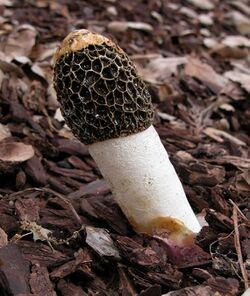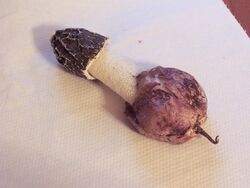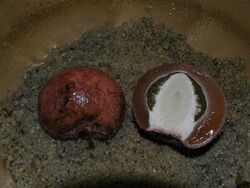Biology:Phallus hadriani
| Phallus hadriani | |
|---|---|

| |
| Scientific classification | |
| Domain: | Eukaryota |
| Kingdom: | Fungi |
| Division: | Basidiomycota |
| Class: | Agaricomycetes |
| Order: | Phallales |
| Family: | Phallaceae |
| Genus: | Phallus |
| Species: | P. hadriani
|
| Binomial name | |
| Phallus hadriani Vent.
| |
| Synonyms[1][2] | |
|
1817 Hymenophallus hadriani (Vent.) Nees | |
| Phallus hadriani | |
|---|---|
| Mycological characteristics | |
| glebal hymenium | |
| cap is conical | |
| spore print is olive | |
| ecology is saprotrophic | |
| edibility: edible but not recommended | |
Phallus hadriani, commonly known as the dune stinkhorn or the sand stinkhorn,[3] is a species of fungus in the Phallaceae (stinkhorn) family. It is a widely distributed species, and is native to Asia, Europe, and North America. In Australia, it is probably an introduced species. The stalk of the fruit body reaches up to 20 cm (7.9 in) tall by 4 cm (1.6 in) thick, and is spongy, fragile, and hollow. At the top of the stem is a ridged and pitted, thimble-like cap over which is spread olive-colored spore slime (gleba). Shortly after emerging, the gleba liquefies and releases a fetid odor that attracts insects, which help disperse the spores. Said to be edible in its immature egg-like stage, it typically grows in public lawns, yards and gardens, usually in sandy soils. Phallus hadriani may be distinguished from the similar P. impudicus (the common stinkhorn) by the presence of a pink or violet-colored volva at the base of the stem, and by differences in odor.
Taxonomy
The species was first described scientifically by the French botanist Étienne Pierre Ventenat in 1798,[4] and sanctioned by Christiaan Hendrik Persoon under that name in his 1801 Synopsis Methodica Fungorum.[5] Christian Gottfried Daniel Nees von Esenbeck called the species Hymenophallus hadriani in 1817;[6] this name is a synonym.[1] According to the taxonomical database Index Fungorum, additional synonyms include: Phallus iosmus, named by Berkeley in 1836; Phallus imperialis, Schulzer, 1873; Ithyphallus impudicus var. imperialis and Ithyphallus impudicus var. iosmos, De Toni, date unknown.[2]
The specific epithet hadriani is named after the Dutch botanist Hadrianus Junius (1512–1575),[7] who wrote a pamphlet on stinkhorn mushrooms in 1564 (Phalli, ex fungorum genere, in Hollandiae sabuletis passim crescentis descriptio).[8]
Description
The immature fruiting bodies of P. hadriani in the egg stage have dimensions of 4 to 6 cm (1.6 to 2.4 in) by 3 to 4 cm (1.2 to 1.6 in), and are colored rosy-pink to violet.[9] They typically have rhizomorphs (aggregations of mycelium that resemble plant roots) at the base.[10] The eggs are enclosed in a tough covering and a gelatinous layer that breaks down as the stinkhorn emerges. Mature fruiting bodies, which may be 10 to 20 cm (3.9 to 7.9 in) tall by 3 to 4 cm (1.2 to 1.6 in) thick, have a white- or cream-colored hollow stipe that is spongy and honeycombed. The head is reticulate, ridged and pitted, and covered with olive green glebal mass. The volva is cuplike, and typically retains its pink color although it may turn brownish with age. Fruit bodies are short-lived, typically lasting only one or two days.[11]
Although the odor of P. hadriani has been described by some authors as faint and pleasant[12] or like violets,[13] others describe the smell as fetid or putrid.[14] The gleba is known to attract insects, including flies, bees, and beetles, some of which consume the spore-containing slime. It is thought that long-distance spore dispersal is facilitated by these insects, who may deposit in their feces intact spores that survive the passage through the digestive tract.[13]
The spores are cylindrical, smooth, and hyaline (translucent), with dimensions of 3–4 by 1–2 µm.[15] The basidia (spore-bearing cells) are cylindrical, with dimensions of 20–25 by 3–4 µm. They have eight sterigmata (slender extensions that attach to the spores), as well as a clamp at their base.[12]
Edibility
Like many other stinkhorns, this species is thought to be edible when in its egg form.[11] Central Europeans and the Chinese consider the eggs a delicacy.[16] Regarding the edibility of mature specimens, one author commented on the genus in general, "No one with his sense of smell developed would think of eating the members of this group."[17]
Similar species
Phallus impudicus has the same overall appearance as P. hadriani, but is distinguished by its white volva.[18] Another similar stinkhorn, P. ravenelii has a smooth, not reticulate head.[10]
Habitat and distribution
Phallus hadriani is known to be in Australia (where it is thought to be an introduced species imported on woodchip mulch used in gardening and landscaping),[14] North America,[11] Europe (including Denmark,[19] Ireland,[20] Latvia,[21] The Netherlands,[22] Norway,[23] Poland,[24] Slovakia,[25] Sweden,[26] Ukraine,[27] and Wales[28]) Turkey (Iğdır Province),[12] Japan ,[29] and China (Jilin Province).[30]
Phallus hadriani is a saprobic species, and thus obtains nutrients by decomposing organic matter. In North America, it is commonly associated with tree stumps, or roots of stumps that are decomposing in the ground.[15] In Great Britain, its distribution is more or less restricted to coastal dunes,[31] while in Poland, it has been noted to avoid humid and humic forest soils, and live in symbiosis with xerophilous grasses and the black locust tree, Robinia pseudoacacia.[32] The mushroom is one of three species protected by the Red Data Book of Latvia.[21]
References
- ↑ 1.0 1.1 "Phallus hadriani Vent. 1798". MycoBank. International Mycological Association. http://www.mycobank.org/MycoTaxo.aspx?Link=T&Rec=245853.
- ↑ 2.0 2.1 "Phallus hadriani Vent.". Species Fungorum. International Mycological Association. http://www.speciesfungorum.org/Names/SynSpecies.asp?RecordID=245853.
- ↑ "Standardized Common Names for Wild Species in Canada". 2020. https://www.wildspecies.ca.
- ↑ Ventenat EP. (1798). "Dissertation sur le genre Phallus" (in fr). Mémoires de l'Institut National Classe des Sciences Mathématiques et Physiques 1: 517.
- ↑ Persoon CH. (1801). Systema Methodica Fungorum. Göttingen: Apud H. Dieterich. p. 246. https://books.google.com/books?id=UugVAAAAYAAJ&q=synopsis%20methodica%20fungorum&pg=RA2-PA246. Retrieved 2010-10-12.
- ↑ Nees von Esenbeck CDG. (1817) (in de). System der Pilze und Schwämme. p. 251.
- ↑ Wilson N. "A mycological voice from the past". Collective Source. http://collectivesource.com/hadrianus/.
- ↑ Schaechter E. (1998). In the Company of Mushrooms: A Biologist's Tale. Cambridge: Harvard University Press. p. 8. ISBN 0-674-44555-4. https://books.google.com/books?id=DSDmd4FfuQ0C&q=phallus%20hadriani&pg=PA8. Retrieved 2010-10-12.
- ↑ Fungi without Gills (Hymenomycetes and Gasteromycetes): an Identification Handbook. London: Chapman and Hall. 1990. p. 244. ISBN 0-412-36970-2.
- ↑ 10.0 10.1 Mushrooms of the Southeastern United States. Syracuse, NY: Syracuse University Press. 2007. p. 277. ISBN 978-0-8156-3112-5. https://books.google.com/books?id=IB1Gv3jZMmAC&q=phallus%20hadriani&pg=PA277. Retrieved 2010-10-12.
- ↑ 11.0 11.1 11.2 "Phallus hadriani". California Fungi. http://www.mykoweb.com/CAF/species/Phallus_hadriani.html.
- ↑ 12.0 12.1 12.2 Demỉrel K; Uzun Y (2004). "Two new records of Phalalles for the mycoflora of Turkey". Turkish Journal of Botany 28: 213–14. http://journals.tubitak.gov.tr/botany/issues/bot-04-28-1-2/bot-28-1-2-22-0207-3.pdf.
- ↑ 13.0 13.1 "Bees and phalloid exudate". Mycologist 16 (3): 109. 2002. doi:10.1017/S0269915X02003105.
- ↑ 14.0 14.1 Smith KN. (2005). A Field Guide To The Fungi Of Australia. Sydney, NSW, Australia: University of New South Wales Press. p. 199. ISBN 0-86840-742-9. https://books.google.com/books?id=ysgx509xB-AC&q=Phallus+hadriani&pg=PA199. Retrieved 2010-10-12.
- ↑ 15.0 15.1 Mushrooms and Other Fungi of the Midcontinental United States (Bur Oak Guide). Iowa City, IA: University of Iowa Press. 2008. p. 249. ISBN 978-1-58729-627-7.
- ↑ Arora D. (1991). All that the Rain Promises and More: a Hip Pocket Guide to Western Mushrooms. Berkeley, CA: Ten Speed Press. p. 241. ISBN 0-89815-388-3. https://books.google.com/books?id=87ct90d4B9gC&q=phallus%20hadriani&pg=PA241. Retrieved 2010-10-12.
- ↑ Marshall N. (2008). The Mushroom Book (Cooking in America). p. 112. ISBN 978-1-4290-1089-4. https://books.google.com/books?id=XWR21PikaJ4C&q=phallus%20genus&pg=PA112-IA7. Retrieved 2010-10-14.
- ↑ "Phallus impudicus and P. hadriani: The Common Stinkhorn (MushroomExpert.Com)". http://www.mushroomexpert.com/phallus_impudicus.html.
- ↑ Lange M. (1957). "Notes on Danish Gasteromycetes H". Svensk Botanisk Tidskrift 53 (3): 307–10.
- ↑ Hassell FC. (1952). "Phallus hadriani (Vent.) Pers. and Geoglossum cookeianum Nanuf. found in Ireland". Irish Naturalists' Journal 10 (9): 250.
- ↑ 21.0 21.1 Vimba E. (1997). "Mycological studies of the Latvian coast of the Baltic Sea and the Gulf of Riga". Proceedings of the Latvian Academy of Sciences Section B Natural Exact and Applied Sciences 51 (5–6): 234–40.
- ↑ "WAD'N GEZWAM! De invloed van schelpenpaden op de paddenstoelendiversiteit van Terschelling" (in nl). Coolia 52 (1): 7–17. 2009.
- ↑ Hoiland K. (1975). "The obligate macromycetes of sand dunes in Norway with special regard to the occurrences on Lista Vest-Agder county southwest Norway". Blyttia 33 (3): 127–40. ISSN 0006-5269.
- ↑ Zabawski J. (1976). "New localities of Phallus hadriani new record in the northwest Poland". Fragmenta Floristica et Geobotanica 22 (4): 623–26. ISSN 0015-931X.
- ↑ Lizon P. (1989). "Epigeous Phallales fungi Gasteromycetidae in Slovakia Czechoslovakia". Annotationes Zoologicae et Botanicae 192: 1–19. ISSN 0570-202X.
- ↑ "Phallus hadriani found in Sodermanland, SE Sweden" (in sv). Svensk Botanisk Tidskrift 98 (5): 274–77. 2004. ISSN 0039-646X.
- ↑ "Gasteromycetes of Fomin Botanical Gardens (Shevchenko State University, Kiev)" (in ru). Mikologiya i Fitopatologiya 13 (6): 468–69. 1979.
- ↑ "The floristics and conservation status of sand-dune communities in Wales". Journal of Coastal Conservation 5: 31–42. 1999. doi:10.1007/BF02802737.
- ↑ "Three species of the genus Phallus rediscovered in Japan" (in ja). Nippon Kingakukai Kaiho 48 (2): 44–56. 2007. ISSN 0029-0289.
- ↑ "Notes on Basidiomycetes of Jilin Province (VI)" (in zh). Journal of Fungal Research 2 (4): 40–43. 2004.
- ↑ British Puffballs, Earthstars and Stinkhorns: an Account of the British Gasteroid Fungi. Kew: Royal Botanic Gardens. 1995. ISBN 0-947643-81-8.
- ↑ Wojewoda W. (1965). "Fungi belonging to the family Phallaceae requiring protection". Chronmy Przyrode Ojczysta 21 (5): 19–24.
Wikidata ☰ Q768006 entry
 |



